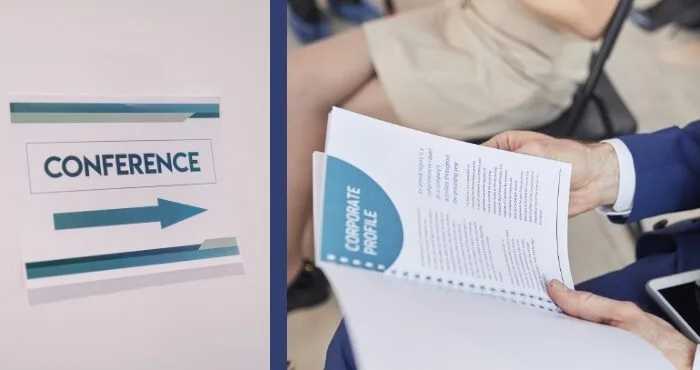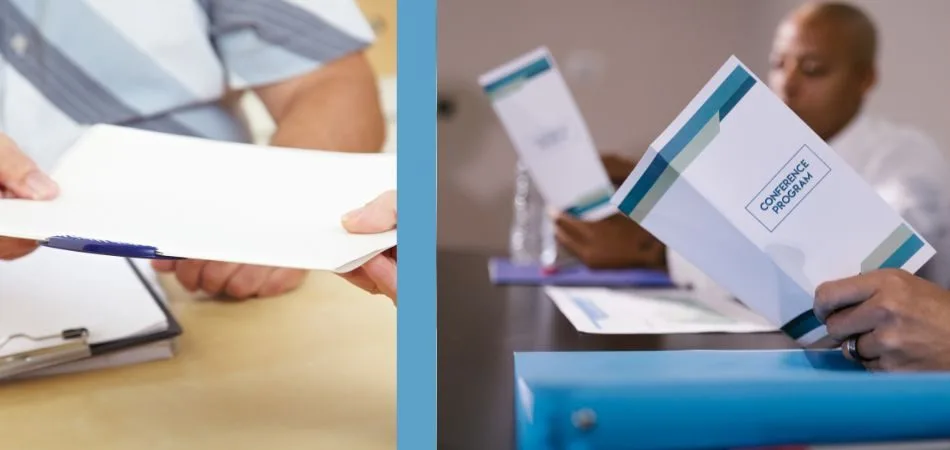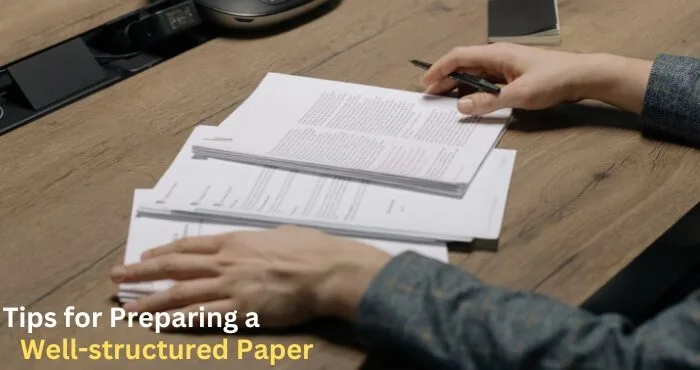A conference is a crucial opportunity for researchers to share their latest research and engage with current trends. This exciting platform not only encourages academic networking but also challenges participants to elevate their work. In this intellectual exchange, conference papers serve as a medium for presenting and analyzing ideas. But what happens after submitting a paper to a conference?
This critical phase involves a precise peer review process, where seasoned experts carefully evaluate your submission’s relevance, quality, and originality. Their comprehensive feedback determines the paper’s fate: it can be accepted, rejected, or returned for further revisions and subsequent resubmission.
This process is fundamental in ensuring the integrity and advancement of academic discourse. In this article, we’ll dive deeper into each stage, providing insights and tips to manage this journey successfully. Stay with us to explore the intricacies of the conference paper submission process.
Core Purpose of the Conference Paper
A conference paper allows researchers to share new ideas, solutions, or findings with peers in their field. It helps the audience stay updated on the latest developments, which allows for discussions that can lead to further discoveries. Through these papers, researchers contribute to their community’s collective knowledge.

Beyond sharing knowledge, conference papers also help researchers build their professional reputation. Presenting at conferences offers networking opportunities, leading to collaborations and feedback for future improvements. This interaction plays a key role in advancing both individual careers and the field as a whole.
Conference papers serve as stepping stones for broader research projects, which may lead to journal publications. They also provide a chance for early-stage research to gain visibility and validation. In this way, innovative ideas are able to reach the right audience and inspire further exploration.
Types of Conference Papers You Can Submit
Researchers have the option of submitting several types of papers to a conference. Each type serves a different purpose, offering unique ways to present your research and ideas. When you choose the right type, you ensure that your work is presented effectively to the intended audience. The following are some key types of conference papers you can submit:
Full Research Paper
This type presents complete research with detailed results and analysis. It typically includes a well-defined problem, methodology, and conclusions. Full research papers are ideal for sharing in-depth studies with substantial contributions. These papers often go through extensive peer review before acceptance.
Short Paper
Short papers offer preliminary research findings or ongoing work. They focus on a specific aspect rather than covering everything in detail. This type helps researchers get early feedback from their peers. It encourages further development and collaboration on the project.
Review Paper
Review papers summarize and analyze the existing literature on a particular topic. They provide insights into trends and gaps in current research. These papers are valuable for guiding future research directions. Conferences welcome them to encourage deeper discussions on relevant topics.
Case Study Paper
Case study papers highlight the real-world applications of theories or practices. They offer insights into practical challenges and solutions in specific cases. These papers are useful for connecting research with industry practices. Presenting case studies encourages learning from real-life experiences.
Conceptual Paper
Conceptual papers introduce new ideas, frameworks, or models. They focus more on theoretical development than on practical results. These papers provide new ways of thinking about existing problems. Conferences use them to encourage innovative discussions and frameworks.
Poster Paper
Poster papers visually summarize research through poster presentations. They provide concise information, allowing for quick engagement with attendees. This format encourages direct interaction and informal feedback. Poster papers are ideal for early-stage or exploratory research.
Knowing these types helps you select the best format for your work. After choosing, follow the steps to submitting a paper to a conference to ensure a smooth process.
Ways to Submit a Paper to a Conference
Submitting a paper to a conference is an important process for researchers. Knowing the process can help ensure your work gets the attention it deserves. Here are key ways to effectively submit your paper and make the most of your conference experience:
Select the Right Conference
Look for conferences that align with your research area and interests. A relevant conference ensures your work reaches the right audience. Consider the conference’s reputation, scope, and deadlines. It’s also helpful to attend conferences to submit papers in person, as it provides valuable networking opportunities.
Know the Guidelines
Every conference has specific submission rules to follow. Review the formatting, structure, and word limit requirements carefully. Missing key guidelines can lead to rejection, even if your paper is strong. Following the instructions shows professionalism and increases your chances.
Prepare Your Paper
Organize your content with clear sections: abstract, introduction, methods, results, and conclusion. Use concise language to communicate your ideas effectively. Ensure your paper is free from errors and follows the required citation style. Proofread it multiple times before submission.
Create an Account on the Conference Portal
Most conferences require online submission. Register with your details and create an account. This account allows you to upload your paper and track its status. Be sure to complete any forms that are required during registration.
Submit Before the Deadline
Always submit your paper ahead of the deadline to avoid technical issues. Last-minute submissions can lead to errors or missed opportunities. Upload all the required documents, including cover letters or abstracts. Confirm your submission by checking your email receipt.
Monitor Submission Status
After submission, monitor your paper’s status on the portal. Some conferences offer updates on peer review progress. Respond promptly if the organizers need additional information. Staying informed helps you prepare for potential revisions.
Prepare for Possible Revisions
Be ready to make changes based on peer reviewers’ feedback. Address comments thoroughly to improve your paper. Revisions are common and part of the process. Properly handling them increases your chances of acceptance.
What Happens After Submitting a Paper to a Conference?
A paper submission to a conference is just the beginning of a long academic journey. By sharing your paper, you give yourself the opportunity for peer review, revisions, and networking. Here’s what happens after you submit a paper to a conference:
Acknowledgement of Receipt
Once submitted, you’ll receive an acknowledgment from the conference organizers. This confirms that your paper has been successfully received. It’s a signal to wait for further communication. Check your email regularly for updates or additional instructions.
Peer Review Process
Your paper enters the peer review stage, where experts in your field evaluate its quality and relevance. They assess the originality of your research, its methodology, and its contributions to the field. This rigorous process ensures the academic integrity of conference presentations.
Decision Notification
After the review, you’ll be notified about the decision on your paper. This could be acceptance, rejection, or a request for revisions. The outcome is based on the reviewers’ evaluations and feedback, guiding your next steps.
Revisions and Resubmission
If revisions are requested, you’ll need to address the reviewers’ comments and improve your paper. This might involve clarifying points, adding data, or refining arguments. After making changes, resubmit your paper for further consideration.
Acceptance and Registration
Upon acceptance, you’ll typically need to register for the conference. This confirms your intent to present your paper and participate in the event. Registration often involves a fee and possibly arranging travel and accommodation.
Presentation Preparation
Prepare to present your paper at the conference. This involves creating a compelling presentation, practicing your speech, and preparing for questions. This stage is crucial for effectively communicating your research to your peers.
Submitting a paper to a conference marks the beginning of an enriching academic journey. It’s a process where your work is reviewed, improved upon, and finally presented. Successfully going through this not only betters your research but also helps you grow professionally and make valuable connections. Each step is a chance to learn and develop in your field.
Can a Paper be Submitted to a Conference Without an Advisor?
Yes, a paper can be submitted to a conference without an advisor. Many conferences welcome submissions from independent researchers, students, and professionals. What matters most is the quality, originality, and relevance of the work presented.
Submitting without an advisor allows you to explore your ideas independently. It encourages personal growth by building research, writing, and presentation skills. There are also specific benefits of submitting a paper without an advisor, such as gaining confidence and learning through self-directed research.
However, it’s important to note that advisors can offer valuable feedback and guidance. Without one, you’ll need to rely more on peer reviews and networking. The process might feel challenging, but it can still be a rewarding learning experience.
Tips for Preparing a Well-structured Paper
A well-structured paper is key to effectively conveying your research. A clear structure aids in presenting your ideas logically and engagingly. Here are some tips to guide you in preparing a paper that connects with your audience:
- Choose a Clear Topic: Start with a precise, focused topic. This helps in developing a clear argument and structure.
- Create an Outline: Draft an outline to organize your thoughts and main points. It serves as a roadmap for your paper.
- Engage with the Introduction: Your introduction should hook the reader and clearly state your thesis. It sets the stage for your argument.
- Develop Strong Body Paragraphs: Each paragraph should address a single idea, supporting your thesis. Use evidence and analysis to bolster your points.
- Conclude Effectively: Your conclusion should summarize key points and restate the thesis. It’s a final opportunity to impact your reader.
- Proofread and Edit: Carefully proofread to eliminate errors and improve clarity. Good editing raise the readability and impact of your paper.
In making your paper, remember that clarity and structure are as important as the content itself. A well-structured paper not only engages the reader but also effectively communicates your research insights. Keep these tips in mind to create a paper that stands out.
FAQs About What Happens After Submitting a Paper to a Conference?
A conference paper submission can raise many questions, especially for those new to the process. These FAQs aim to address common concerns and provide clear guidance on what to expect next. From knowing deadlines to preparing presentations, here are answers to key questions that will help you manage this process smoothly:
How Long Does It Take to Hear Back After Submission?
The review process can take a few weeks to several months, depending on the conference. Reviewers need time to evaluate submissions thoroughly, ensuring fair and accurate decisions. Check the conference’s timeline for expected notification dates. Patience is essential, as each step contributes to the event’s quality.
Can You Withdraw a Paper After Submitting It?
Yes, most conferences allow withdrawal before the review process is complete. However, it’s crucial to notify organizers early if you need to withdraw. Withdrawing after acceptance may affect your reputation with the conference. Always review the conference’s withdrawal policies before submitting.
What Happens if Your Paper Gets Lost or Misplaced?
It’s rare, but technical issues can occasionally cause submissions to be lost. Always save confirmation emails and submission receipts for reference. If you don’t receive updates, contact the organizers to ensure they received your paper. Proactive communication prevents delays or misunderstandings.
Are There Fees Involved After Submitting a Paper?
Submitting is usually free, but registration fees apply if your paper is accepted. These fees cover participation and conference materials. In some cases, travel or accommodation costs are also required. Check the conference website for fee-related details.
Can You Submit the Same Paper to Multiple Conferences?
Generally, simultaneous submissions to multiple conferences are not allowed. Most conferences have strict policies against this practice to maintain fairness. If caught, your paper could be rejected from all conferences involved. Always check individual policies before considering multiple submissions.
What If You Miss the Revision Deadline?
Missing a revision deadline may result in automatic rejection of your paper. Some conferences may provide short extensions upon request. It’s essential to communicate with organizers if unexpected delays arise. Staying organized helps you meet deadlines without stress.
Conclusion
When a paper is submitted to a conference, a significant journey begins. It’s a process that begins with anticipation and the hope of sharing one’s work with a wider audience.
As part of this journey, researchers are asked to answer the question, “What happens after submitting a paper to a conference?” In response, an expert peer review is conducted, which impacts a paper’s future and the researcher’s development overall.
At the end of this process, the paper will be presented, where feedback will be tangible, and learning will be shared. It’s a cycle that not only improves academic discourse but also contributes to personal and professional development.







